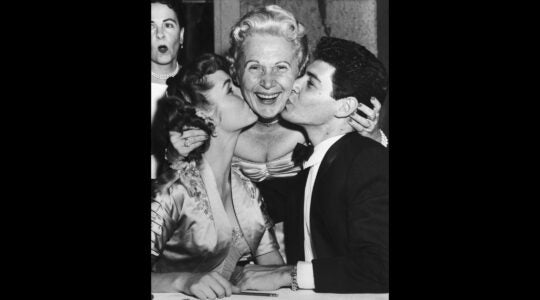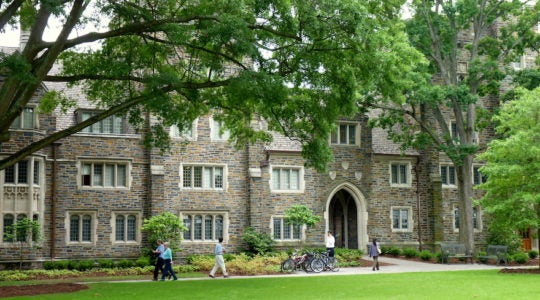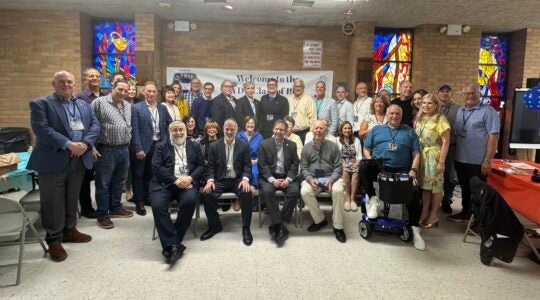Even as Wednesday’s summit meeting in Aqaba, Jordan, kicked off the first steps down the road map to achieving Israeli-Palestinian peace, the government of Israel is continuing to erect an elaborate security barrier to separate Israel from Palestinian communities in the West Bank.
Gerald Steinberg, a political science professor at Bar-Ilan University, called the multimillion-dollar barrier a costly "insurance policy."
"Insurance is always expensive," said Steinberg. "The best way to prevent the cost of a disaster is to have a good insurance policy.
"Israelis are in favor of the road map, but they don’t believe it will succeed. So this is their safety net. The road map may come to an end today or tomorrow, and if it fails, Israel is under no obligation to divide the territory.
"The only way the Palestinians get contiguity [for their own state] is if they fulfill their end of the road map."
A survey released this week by the Steinmetz Center for Peace Research at Tel Aviv University found that although 59 percent of Israelis said they favor the road map, 66 percent said they do not believe it will lead to a comprehensive peace.
Nevertheless, Stephen Cohen, national scholar of the Israel Policy Forum, hailed Wednesday’s summit with President George W. Bush, Sharon, Palestinian Prime Minister Mahmoud Abbas and Jordan’s King Abdullah as an "important moment in the history of Israel. … It gives me a lot of hope for the future of Israel."
"The most important thing is to understand that Sharon brought the key elements of his cabinet with him to make this statement, and Israel is now committed to a viable Palestinian state with contiguous territory, which is an historic breakthrough in the history of [Sharon’s] Likud Party," Cohen said.
In his Aqaba speech, Sharon said Israel would "immediately begin to remove" unauthorized settlement outposts scattered throughout the West Bank. He made no mention of established settlements, but he promised to restore "normal life" for Palestinians once there is a crackdown on terrorism.
Sharon noted that Abbas committed himself to developing one military force under the leadership of the central government. The Israeli leader also pointed out that the United States was dispatching John Wolf, an assistant secretary of state with no Middle East background, to Israel to monitor implementation of the road map (see sidebar).
Cohen said that in furtherance of Bush’s "totally unexpected level of commitment to the process," the president was assigning Secretary of State Colin Powell and National Security Adviser Condoleezza Rice to take responsibility for progress.
"We should celebrate the fact that the United States and Israel now have a shared strategic vision for the future of Israel and of the Middle East," Cohen added.
Asked about the security barrier, Cohen said: "That is all a legacy of the past. The prime minister has now said … there will be a contiguous Palestinian state, which means that Palestinians will be able to walk from one end of their state to the other with no walls. There will be no cantons. Say goodbye to that."
Malcolm Hoenlein, executive vice chairman of the Conference of Presidents of Major American Jewish Organizations, said the summit was "very dramatic, but the test will be the implementation. … It was very hopeful, and we heard declarations [about ending Palestinian] incitement and an end to terrorism. I think that everybody wants to see peace (if it could be a real peace) and everybody should welcome it."
"People should not expect that this will be a panacea," he said. "But Sharon has been extremely forthcoming and he will face internal political problems similar to what Abbas will face now."
Hoenlein said that although Abbas did not mention dismantling the terrorist infrastructure, the fact that Palestinian President Yasir Arafat was sidelined was important.
"Now we have to see if they can wrest control from him of the power he still holds," Hoenlein said. "And there is a mistaken notion that terrorism is ending. Yesterday there were 12 different attacks and 63 hot warnings about suicide bombings."
He said the Palestinian terrorist infrastructure must be dismantled, something that will "only come about through a confrontation." And it should happen quickly, Hoenlein said, because the terror groups are looking for a pause to rebuild because Israel has eliminated much of their leadership and dealt the groups a "body blow."
"Is he going to remove the terrorists, or just negotiate with them?" Hoenlein asked of Abbas.
Regarding the security barrier, Hoenlein pointed out that Bush said in his statement that facts on the ground would not be an impediment to fulfilling the road map.
But Morton Klein, president of the Zionist Organization of America, said the promises made by Abbas were the same ones Arafat made at Oslo and during the Hebron agreement. They "amounted to nothing," Klein said, "because they were never translated into action."
"My only hope is that the Israeli government and America will hold accountable the Palestinian Authority to change the textbooks, media and official speeches that promote the hatred and murder of Jews," he said. "They should demand that terror groups be dismantled and that terrorists are arrested. If Hamas and Islamic Jihad were made illegal and their weapons confiscated … and if this continued over a long period of time, then there would be a basis for hope."
View From
The Settlements
Those views were echoed by Raphaella Segal, a spokeswoman for the West Bank Israeli settlement of Kedumim, who said Sharon appears to have set aside all the preconditions he had to accepting the road map.
"He had said the Palestinians had to forego the right of return, that the Palestinian Authority had to be changed to a group not connected with terror, that all illegal weapons had to be collected and that a cease-fire" was not sufficient, that the terrorist infrastructure had to be destroyed, she said.
"All of these conditions he has given up in the last two to three weeks," Segal said. "We can’t rely on him anymore."
A group of 375 American congregational rabbis from each denomination signed a statement expressing concerns about the road map, even though some of them may support it. They said the Palestinians must still give up the right of return, must dismantle the terrorist infrastructure and that advances along the road map must be made based on performance and not timetables.
On the other hand, Henry Siegman, a senior fellow at the Council on Foreign Relations, said he is optimistic about the road map because of Bush’s direct involvement.
"He has taken certain steps from which he cannot pull back," Siegman said. "That is the single most important assurance that this road map has hope. It can’t be done without this type of personal involvement, and he can’t pull back now without a loss of credibility. And that is the best thing that has happened for peace in the Middle East in a long, long time."
Siegman pointed out that by enlisting the support of moderate Arab nations in a meeting in Egypt a day before the Israeli-Palestinian summit, Bush was correcting a mistake made by President Bill Clinton, who had "ignored the Arab countries."
"Arab leaders want to feel that the president takes their views seriously," he said. "If not, he can’t turn to them later."
Although Abbas made no mention of dismantling the Palestinian terrorist infrastructure, he did pledge to use every means at his disposal to end armed attacks on Israelis "wherever they may be," a clear reference to those living in the territories whom Palestinian terrorists have insisted are fair game.
He vowed also to use "all our efforts … to bring an end to the armed intifada [uprising]" against Israel. Media reports prior to his statement said Arafat, with whom both the U.S. and Israel refuse to deal because of his continued commitment to terrorism, had urged Abbas to change the statement from "armed intifada" to a "popular uprising."
"The fact that he stayed with his original text is important," Steinberg observed.
But after Tuesdayís meeting with Bush and several moderate Arab leaders in Egypt, Abbas reportedly spoke with Arafat for an hour to brief him on the meeting. And Arafat reportedly delayed by one day last week’s meeting between Abbas and Sharon, apparently in another effort to show he is still boss: something Abbas and other Palestinian leaders readily acknowledge.
Bobby Brown, a former adviser to Prime Ministers Ehud Barak and Benjamin Netanyahu, said the upcoming negotiations on the road map will be a true test of whether Abbas "is just a front man or has the power. If he has the power, he has a chance for success."
If not, Brown said, Arafat will do everything he can to scuttle peace efforts unless it is "substantially more" than what he was offered by Barak during the waning days of his administration in January 2001. For Abbas to accept anything less would make Arafat "look stupid" for not accepting Barak’s offer.
Brown said that after the killing of nearly 800 Israelis during 32 months of violence, Israel is in no position to offer even what Barak had proposed.
An extensive article on the security fence was reported last week by Meron Rappaport in the Israeli daily Yediot Achronot. He claimed the barrier would split the West Bank into three parts: from Jenin to Ramallah, from Bethlehem to Hebron, and surrounding the city of Jenin. It would put about 12,000 Palestinians and about 13 Palestinian villages on the Israeli side of the fence and cut off about 30,000 Palestinians from the farmland they have worked.
Although initially seen as a barrier along the Green Line, Israel’s 1967 border, Rappaport said it has expanded east in order to "put as many settlements on the Israeli side of the fence" and to conform to Sharon’s own map for a Palestinian state on slightly more than 40 percent of the West Bank and split into pieces.
But Steinberg disputed Rappaport’s report about the position of the barriers, saying there are "a lot of different maps floating around" and the government has not approved the location of the barrier in its entirety. Only about 100 miles have been erected, which represents about one-third of the entire structure. The barrier is as wide as a mile in some locations and includes barbed wire, a deep ditch, a dirt road that would reveal the footprints of intruders, a 24-foot high fence and security cameras.
The New York Jewish Week brings you the stories behind the headlines, keeping you connected to Jewish life in New York. Help sustain the reporting you trust by donating today.




